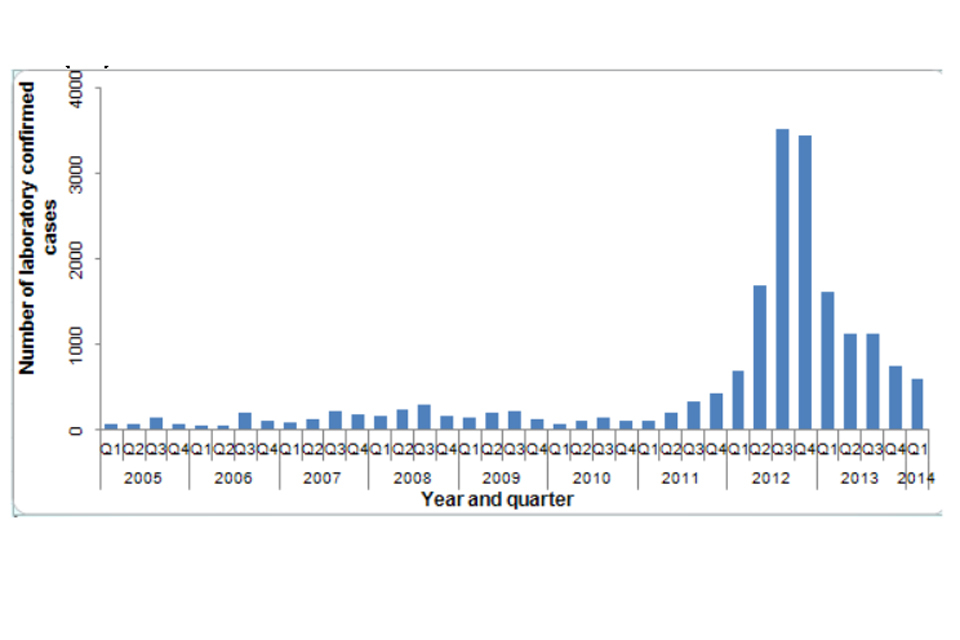Laboratory confirmed cases of pertussis reported to the enhanced pertussis surveillance programme in England: January to March 2014
Updated 22 May 2015
In England there were 605 laboratory confirmed cases of pertussis (culture, PCR, serology or oral fluid) reported to PHE’s pertussis enhanced surveillance programme in the first quarter of 2014, from January to March (see table). This was a 19% decrease in the number of cases reported during the previous quarter (747 in October to December 2013) and a 63% decrease on cases reported in the same quarter of 2013 (1625 cases between January and March 2013). There were 18 laboratory confirmed cases reported in Wales between January and March 2014, a 33% decrease in the 27 cases reported in the fourth quarter in 2013.
Typically pertussis activity peaks in the third quarter and then declines, as observed in previous years (see figure). The continued increase observed in each successive quarter between the first quarter of 2011 and third quarter of 2012 was unusual. The HPA declared a national outbreak of pertussis (level 3 incident [1]) in April 2012 and, as a response to the ongoing outbreak, the Department of Health announced the introduction of a temporary immunisation programme for pregnant women on 28 September 2012 [2]. The most recent PHE figures report that – of the mothers due to give birth in January, February and March 2014 – 60.7%, 59.7% and 58.9% respectively had been immunised with a pertussis containing vaccine in pregnancy in England [3].
Following the high levels of activity, confirmed cases of pertussis first fell in the fourth quarter of 2012 and this decrease has continued overall to the first quarter of 2014 with a slight increase in the third quarter of 2013 in line with the usual seasonal pattern. The highest number of laboratory confirmed cases in England persisted in individuals aged 15 years and over whilst disease incidence continued to be highest in infants <3 months.
Confirmed cases in infants less than three months were 54% lower in the first quarter of 2014 (12 cases) than the equivalent quarter in 2013 (26 cases) and similar to the last quarter of 2013 (13 cases). One pertussis related infant death was reported for infants tested between January and March 2014 in England.
These early data in young infants following the introduction of a programme to immunise pregnant women are encouraging. It is important to be aware, however, that raised levels of pertussis persist in older age groups. Women should continue to be encouraged to be immunised against pertussis during pregnancy in order to protect their babies from birth.
| Age group | Culture | PCR | Serology | Oral fluid only | Total |
|---|---|---|---|---|---|
| <3 months | 9 | 3 | – | – | 12 |
| 3-5 months | 1 | 3 | 1 | – | 5 |
| 6-11 months | 2 | 1 | – | – | 3 |
| 1-4 years | – | 1 | 4 | 2 | 7 |
| 5-9 years | 1 | 1 | 17 | 5 | 24 |
| 10-14 years | – | 1 | 68 | 11 | 80 |
| 15+ years | 2 | 3 | 464 | 5 | 474 |
| Total | 15 | 13 | 554 | 23 | 605 |
Table. Laboratory-confirmed cases of pertussis by age and testing method in England, January to March 2014

Total number of laboratory-confirmed cases of pertussis per quarter in England, 2005 to 2014 (Q1)
1. Laboratory investigation
Bordetella pertussis PCR (for hospitalised cases <1 year old) and serological investigation by estimation of anti-pertussis toxin (PT) IgG antibody levels for older children and adults are provided by the Respiratory and Vaccine Preventable Bacteria Reference Unit (RVPBRU) at the Public Health England (PHE) Microbiology Services Division Colindale. The PCR service for hospitalised infants under 1 year requires either a pernasal swab or nasopharyngeal aspirate to be sent as soon as possible post-onset; for the pertussis serology service for older children and adults not less than 400 μl of separated serum should be sent at least 2 to 3 weeks post-onset. Serology testing is not suitable for any individual who has been immunised against pertussis in the last year. The laboratory also encourages submission of all Bordetella pertussis isolates for confirmation and national surveillance purposes.
Since January 2013, the RVPBRU is offering an oral fluid (OF) testing service for clinically suspected cases reported to local Health Protection Teams, who are aged between 8 to 16 years (<17yrs) and for children aged 5 to <17 years from 14 October 2013 who have been coughing for more than 2 weeks and have not been immunised against pertussis in the previous year. A new PCR community testing pilot for all age groups began at the end May 2013 and requires a pernasal, throat swab and OF swab to be sent to RVPBRU for testing.
Further information is available in the PHE Bacteriology Reference Department user manual at: http://www.hpa.org.uk/cfi/rsil/bordetella.htm.
2. References
- Health Protection Report 6 (15), 13 April 2012. http://www.hpa.org.uk/hpr/archives/2012/news1512.htm#prtsss
- Department of Health: https://www.gov.uk/government/news/pregnant-women-to-be-offered-whooping-cough-vaccination.
- Public Health England: https://www.gov.uk/government/publications/pertussis-vaccine-uptake-in-pregnant-women-october-2012-to-march- 2014
This report was published in Health Protection Report volume 8 issue 25.
